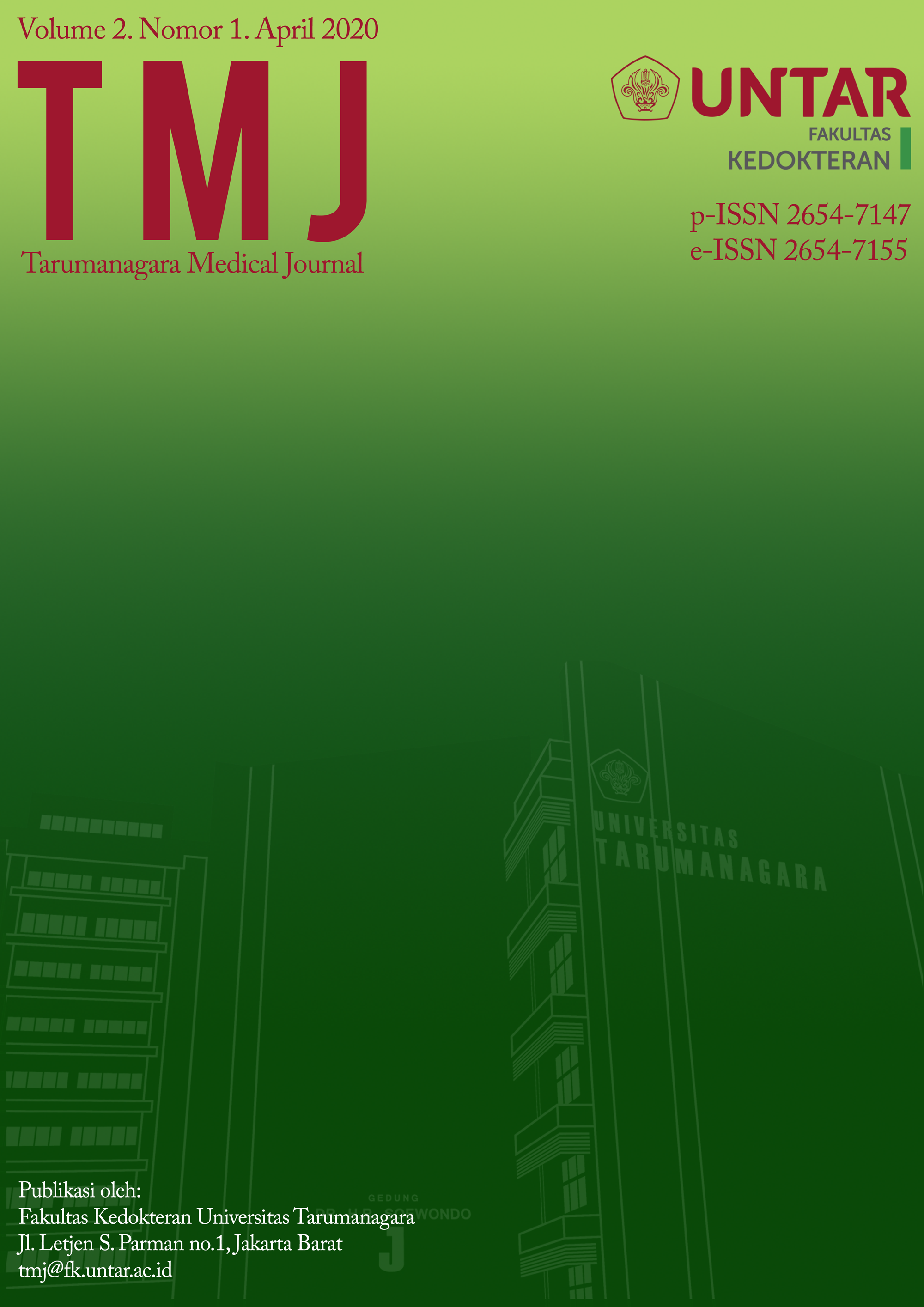Hubungan persalinan seksio sesarea dengan hyperbilirubinemia neonatus
Main Article Content
Abstract
Hiperbilirubinemia neonatus merupakan masalah klinis yang umum dihadapi selama periode neonatal. Persalinan seksio sesarea adalah salah satu faktor maternal untuk terbentuknya hiperbilirubinemia. Kejadian hiperbilirubinemia yang diprediksi sebelum melahirkan dapat mencegah komplikasi dan untuk mengenali dengan cepat ikterus pada bayi baru lahir. Studi ini bertujuan untuk mengetahui hubungan persalinan seksio sesarea dengan hiperbilirubinemia neonatus. Studi cohort retrospektif ini dilakukan pada 124 neonatus yang mengalami hiperbilirubinemia di RS Sumber Waras pada tahun 2019. Pengambilan sampel menggunakan teknik non-random consecutive sampling. Data dianalisis dengan uji Mann-Whitney. Didapatkan 50,8% diantaranya bayi berjenis kelamin laki-laki, 74,2% dilahirkan secara seksio sesarea. Rata-rata pemeriksaan bilirubin dilakukan pada usia lima atau enam hari. Tingkat rata-rata kadar bilirubin total yang didapatkan adalah 14,62;4 mg/dL, dengan rata-rata kadar bilirubin direk adalah 0,64;0,4 mg/dL dan rata-rata kadar bilirubin indirek adalah 13,97;4 mg/dL. Sebanyak 25% bayi memiliki kadar bilirubin total antara 5-12 mg/dL, 70,2% antara 12-20 mg/dL dan 4.8% bayi memiliki kadar bilirubin diatas 20 mg/dL. Tingkat rata-rata kadar bilirubin total pada kelompok seksio searea dan spontan masing-masing adalah 14,39 mg/dL dan 15,3 mg/dL (p value = 0,239). Tidak terdapat hubungan yang bermakna antara persalinan seksio sesarea dengan hiperbilirubinemia neonatus.
Article Details

This work is licensed under a Creative Commons Attribution-NonCommercial-ShareAlike 4.0 International License.
Penulis yang menerbitkan artikelnya di Tarumanagara Medical Journal (TMJ) setuju dengan ketentuan sebagai berikut:
- Penulis mempertahankan hak cipta dan memberikan jurnal hak publikasi pertama dengan bekerja secara bersamaan dilisensikan di bawah Creative Commons Attribution yang memungkinkan orang lain untuk berbagi karya dengan pengakuan atas kepengarangan dari karya asli dan publikasi dalam jurnal ini.
- Penulis dapat masuk ke dalam pengaturan kontrak tambahan yang terpisah untuk distribusi non-eksklusif jurnal versi pekerjaan yang dipublikasikan (misalnya, memposting ke repositori institusional atau menerbitkannya dalam buku), dengan pengakuan publikasi awal dalam jurnal ini.
- Setiap teks yang dikirim harus disertai dengan "Perjanjian Transfer Hak Cipta" yang dapat diunduh melalui tautan berikut: Unduh
References
Watchko JF. Extreme neonatal hyperbilirubinemia: a view from down under [Internet]. J Pediatr. 2016 [cited 2018 Oct 12];168:7-9. Available from: https://www.jpeds.com/article/S00223476(15)01129-4/fulltext
Maheshwari A, Carlo WA. Digestive system disorders. In: Kliegman RM, Stanton BF, St Geme JW, Schor NF, editors. Nelson textbook of pediatrics. 20th ed. Phialdelphia: Elsevier; 2016. p. 871-5.
National Institutes for Health and Clinical Excellence. Neonatal jaundice [Internet]. [updated 2010 May; cited 2018 Oct 12]. Available from: https://www.nice.org.uk/guid ance/cg98/evidence/full-guideline-245411821
Slusher TM, Zipursky A, Bhutani VK. A global need for affordable neonatal jaundice technologies [Internet]. Semin Perinatol. 2011 [cited 2018 Oct 12];35:185–91. Available from: https://www.sciencedirect.com/science/article/pii/ S0146000511000437
Cunningham FG, Leveno KJ, Bloom SL, Hauth JC, Rouse DJ, Spong CY. Williams obstetrics. 23rd ed. New York: McGraw-Hill; 2008. p. 374-84, 544.
Lumbiganon P, Laopaiboon M, Gulmezoglu AM, Souza JP, Taneepanichskul S, Ruyan P, et al. Method of delivery and pregnancy outcomes in Asia: the WHO global survey on maternal and perinatal health 2007–08 [Internet]. Lancet. 2010 [cited 2018 Oct 22];375(9713):490–9. Available from: https://www.thelancet.com/ journals/lancet/article/PIIS01406736(09)61870-5/ fulltext
Betrán AP, Ye J, Moller AB, Zhang J, Gülmezoglu AM, Torloni MR. The Increasing Trend in Caesarean Section Rates: Global, Regional and National Estimates: 1990-2014 [Internet]. PLoS One. 2016 [cited 2018 Oct 22];11(2):e0148343. Available from: https://journals.plos.org/plosone/article? id=10.1371/journal.pone.0148343
Festin MR, Laopaiboon M, Pattanittum P, Ewens MR, Henderson-Smart DJ, Crowther CA. Caesarean section in four South East Asian countries: reasons for, rates, associated care practices and health outcomes [Internet]. BMC Pregnancy and Childbirth. 2009 [cited 2018 Oct 22];9:17. Available from: https://www. ncbi.nlm.nih.gov/pmc/articles/PMC2695422/
Geller EJ, Wu JM, Jannelli ML, Nguyen TV, Visco AG. Neonatal Outcomes Associated with Planned Vaginal versus Planned Primary Cesarean Delivery [Internet]. Journal of Perinatology. 2010 [cited 2019 Apr 3];30:258-64. Available from: https://www.nature.com/ articles/jp2009150.pdf?origin=ppub
Huang A, Tai BC, Wong LY, Lee J, Yong EL. Differential risk for early breastfeeding jaundice in a multi-ethnic Asian cohort [Internet]. Ann Acad Med Singapore. 2009 [cited 2019 Jul 8];38(3):217-24. Available from: http://www.annals.edu.sg/pdf/38VolNo3Mar2009/V38N3p217.pdf?ev=pub_ext_prw_xdl
Brits H, Adendorff J, Huisamen D, Beukes D, Botha K, Herbst H, et al. The prevalence of neonatal jaundice and risk factors in healthy term neonates at National District Hospital in Bloemfontein [Internet]. Afr J Prim Health Care Farm Med. 2018 [cited 2019 Jul 8];10(1):e1-6. Available from: https://www.ncbi.nlm.nih.gov/ pmc/articles/PMC5913776/pdf/PHCFM-10-158 2.pdf
Garosi E, Mohammadi F, Ranjkesh F. The relationship between neonatal jaundice and maternal and neonatal factors [Internet]. Iranian Journal of Neonatology. 2016 [cited 2018 Nov 5];7(1):37-40. Available from: http://ijn.mums.ac.ir/article_6663_9bb7af7d47aa91a1b565c95c961afe37.pdf
Bilgin BS, Koroglu OA, Yalaz M, Karaman S, Kultursay N. Factors affecting bilirubin levels during first 48 hours of life in healthy infants [Internet]. Biomed Res Int. 2013 [cited 2018 Oct 1];2013:316430. Available from: https://www.hindawi.com/journals/bmri/2013/316430/
Yazdiha MS, Naghibzadeh M, Ghorbani R, Emadi A, Hoseinzadeh B, Gohari A. The Relationship between Types of Delivery and Methods of Anesthesia with Occurrence of Jaundice in Term Neonates [Internet]. Iranian Journal of Neonatology. 2018 [cited 2019 Apr 3];6(7):7959-64. Available from: http://ijp.mums.ac.ir/article_10353_8aba96b1c8041b5d7e9b0a7dc0fc348b.pdf
Farhat AS, Hafizi L, Pourhoseini MT, Halimi F, Mohamadzadeh A, Saeidi R. Comparison of bilirubin level in term infants born by vaginal delivery and caesarian section [Internet]. Iranian Journal of Neonatology. 2016 [cited 2019 Apr 3];7(4): 45-49. Available from: http://ijn.mums.ac.ir/article_7189_7e5768f85ecbe56ff5 0f7eed58401e34.pdf



